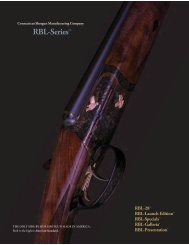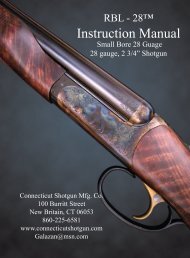Connecticut Shotgun's RBL-28
Connecticut Shotgun's RBL-28
Connecticut Shotgun's RBL-28
Create successful ePaper yourself
Turn your PDF publications into a flip-book with our unique Google optimized e-Paper software.
en Anson & Deeley design with Purdey-style<br />
double underbolts, Southgate<br />
ejectors, flat V mainsprings and a reliable<br />
inertial selective single trigger or double<br />
triggers as you wish. The major interior<br />
wearing parts are coated in durable goldcolored<br />
titanium nitrite just like a highspeed<br />
drill bit. The coating is tough, rustproof<br />
and looks nice.<br />
Is the gun built on a true <strong>28</strong>-gauge action<br />
Maybe yes, maybe no. I put the<br />
<strong>28</strong>-gauge barrels onto the 20-gauge receiver<br />
and the 20’s barrels onto the <strong>28</strong>’s<br />
receiver just to see if I could. Everything<br />
fit. The opening levers came over the correct<br />
amount, and the guns locked up nicely.<br />
Kudos to the magic of CNC and EDM.<br />
The only real differences were the larger<br />
fences on the 20 and a few thou of width<br />
at the sides near the forend iron. I did not<br />
measure the difference in receiver weights,<br />
but it couldn’t amount to much. Frankly,<br />
this sized receiver stuff doesn’t really<br />
matter. The <strong>28</strong>’s receiver looks in correct<br />
proportion, and that’s what counts.<br />
All the <strong>RBL</strong>-<strong>28</strong>s have case-colored receivers.<br />
The optional French gray of the<br />
<strong>RBL</strong>-20s has been discontinued. Coloring<br />
is oven baked in a traditional boneand-charcoal<br />
pack. As before, the engraving<br />
is done by machine, but the <strong>RBL</strong>-<strong>28</strong>’s<br />
scroll with setter and pointer on the sides<br />
and a grouse on the bottom seems shallower,<br />
or at least less distinct, than the engraving<br />
on the 20. The <strong>28</strong>’s engraving<br />
gets lost in the case coloring.<br />
The barrels on the <strong>28</strong> carry a good-quality,<br />
medium-gloss rust blue. CSMC tried<br />
a military-spec, thermal-set barrel coating<br />
on the early <strong>RBL</strong>-20s but went back<br />
to doing it the old-fashioned way. Chambers<br />
are 2 3 /4", as befits the <strong>28</strong> gauge, and<br />
forcing cones are standard length. As before,<br />
the barrel bores are chromed, but<br />
this time screw chokes are out and fixed<br />
chokes are in. My guess is that this was<br />
done to keep the barrel weight down and<br />
the gun’s balance neutral. Barrel lengths<br />
of 26", <strong>28</strong>" and 30" are now offered instead<br />
of only <strong>28</strong>" on the 20-gauge. If you<br />
request it, CSMC will give you whatever<br />
fixed chokes you wish. If you don’t<br />
stipulate, the 26" barrels get Skeet and<br />
IC, whereas the longer tubes come Modified<br />
and Full. The top rib is a beautiful<br />
English-style swamped game rib, which<br />
lends a graceful look to the gun’s profile.<br />
Due to a hiccup in communication, my<br />
<strong>28</strong>" barrels came through with the M/F<br />
chokes, but I was promised one-day factory<br />
turnaround to open them up. This is<br />
a good place to mention that CSMC has<br />
earned an excellent reputation for quick<br />
and courteous service. The company was<br />
quick to make good on any initial flaws in<br />
the early production <strong>RBL</strong>-20s. I measured<br />
both bores at .551", almost a perfectly<br />
nominal .550" for the <strong>28</strong>. The barrels<br />
on my gun are quite light, and no wonder:<br />
Barrel-wall thickness just behind the<br />
chokes was .065". This is certainly safe,<br />
but it is a good bit svelter than so many of<br />
the clunky mass-produced barrels made<br />
by some other makers today. Give credit<br />
to first-rate machinery, first-rate machinists<br />
and those fixed chokes.<br />
The wood options on the <strong>RBL</strong>-<strong>28</strong> are<br />
the same as they were on the 20: English<br />
or pistol grip and splinter or beavertail<br />
forend. As it should be, the wrist on my<br />
<strong>28</strong> was slimmer than the wrist on the 20,<br />
and it felt much better. The <strong>28</strong> retains the<br />
“no screws” long trigger-guard tang that<br />
slips into a hidden fastener in the stock.<br />
In all, the <strong>28</strong> is a gorgeous and properly<br />
proportioned package. My only little<br />
touches of aesthetic whining are that the<br />
trigger guard seems a bit oversized, the<br />
curve of the single trigger isn’t particularly<br />
graceful (but it is comfortable) and the<br />
bright silver of the Anson forend push button<br />
seems out of place against the bluing<br />
and case coloring of the rest of the gun.<br />
But these are small things, and you may<br />
very well prefer them the way they are.<br />
Then there is the wood. My gun was<br />
ordered with exhibition walnut for an extra<br />
$900. All of the <strong>RBL</strong> exhibition walnut<br />
I’ve seen has been absolutely first<br />
rate, but my piece hit the lumber Lotto.<br />
Lascivious walnut won’t improve my<br />
shooting, but it sure takes the pain out of<br />
the misses.<br />
I took the gun through a combination<br />
of barrel testing, considerable clay shooting<br />
and three days of plantation quail.<br />
The barrel tests showed that the chokes<br />
shot tight as expected for M/F. If I were<br />
to use the gun for distant doves, these<br />
might work, but for quail, grouse, woodcock<br />
or snipe you would be well to consider<br />
the .006" and .012" Skeet and Light<br />
Modified for best coverage in the 15- to<br />
30-yard range.<br />
Barrel convergence—the ability of<br />
both barrels to shoot to the same point—<br />
was spot-on perfect. This is a critical but<br />
often overlooked aspect of a gun. Surprisingly<br />
few doubles have perfect convergence,<br />
so this is a tribute to CSMC’s barrel<br />
regulation. One major maker feels that<br />
8" separation is acceptable at 40 yards,<br />
but I don’t. That would cost you a third of<br />
your effective pattern.<br />
The gun is set up to shoot flat. For most<br />
people, the standard stock drop of 1 1 /2"<br />
at comb and 2 3 /8" at heel will show a fair<br />
amount of rib, but the gun does not shoot<br />
as high as it looks. It worked out perfectly<br />
for the majority of the shooters I loaned<br />
it to. Initially, many complained that the<br />
stock was too high, but they were pleasantly<br />
surprised when the gun shot dead on for<br />
them. Others who are used to high combs<br />
felt that the gun shot a little lower than the<br />
sight picture indicated, and they had to<br />
cover their targets to get a hit. Light-barreled<br />
sub-gauge side-by-side guns, like<br />
this <strong>28</strong>, are reputed to have more barrel<br />
down flip than other guns. This might be<br />
why the gun shoots so flat while showing<br />
an elevated sight picture. The choice of<br />
14 1 /4" or 14 3 /4" lengths of pull makes the<br />
gun suitable for a broad range of shooters.<br />
I felt that the stock could have used a<br />
bit more pitch, but no one else commented<br />
on this, so I must be the odd man out.<br />
The most noticeable shooting characteristic<br />
of the gun was its swing speed. At<br />
a featherweight 5 pounds 10 ounces—<br />
versus 6 pounds 2.4 ounces for a similarly<br />
set up <strong>RBL</strong>-20—and balanced on the<br />
hinge pin, this <strong>RBL</strong>-<strong>28</strong> is Ferrari fast. It<br />
reminded me very much of the <strong>28</strong>-gauge<br />
Parker Reproduction: Both move like<br />
lightning. In exchange for the reflexive<br />
speed and the ability to make instant corrections,<br />
you will be required to concentrate<br />
more on your swing so as not to stop<br />
the gun. The inertia of the gun won’t keep<br />
it moving for you the way it will on a gun<br />
with more weight forward. For comparison,<br />
I tried a 30" <strong>RBL</strong>-<strong>28</strong> with a beavertail<br />
forend and pistol grip. It was a little<br />
more sedate, but not much.<br />
Compared to the <strong>RBL</strong>-20 Launch Edition,<br />
the <strong>RBL</strong>-<strong>28</strong> is a more specialized<br />
gun. It is featherweight, lightning fast,<br />
mechanically correct and absolutely gorgeous.<br />
It’s a classy gun in a classy gauge.<br />
And it won’t stop there. CSMC is now<br />
also producing <strong>RBL</strong>s in 12 and 16 gauge.<br />
The hefty 3" magnum <strong>RBL</strong>-12s I’ve handled<br />
have been built with a weight-forward<br />
bias meant for waterfowl and sporting<br />
clays. The scaled-frame <strong>RBL</strong>-16s are<br />
a good bit lighter and more neutrally balanced<br />
for upland work. CSMC has even<br />
added a 20-gauge rifled version of the<br />
<strong>RBL</strong>-20 for saboted slugs complete with<br />
iron sights and scope mounts. All continue<br />
the <strong>RBL</strong> tradition of an Americanmade<br />
shotgun of good quality at a reasonable<br />
cost. Well done, indeed.<br />
Author’s Note: For more information<br />
on <strong>RBL</strong> shotguns, contact <strong>Connecticut</strong><br />
Shotgun Mfg. Co., 860-225-6591; www<br />
.connecticutshotgun.com.<br />
shootingsportsman.com 101





